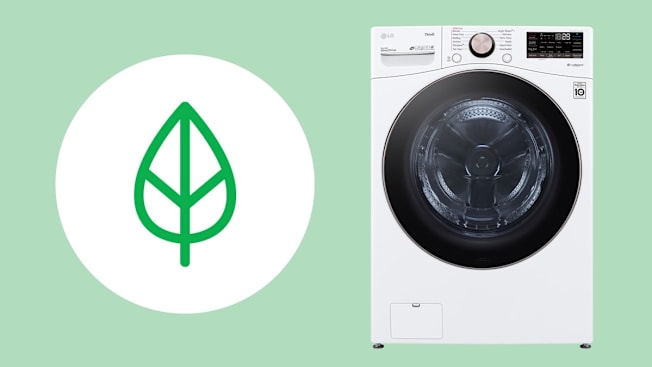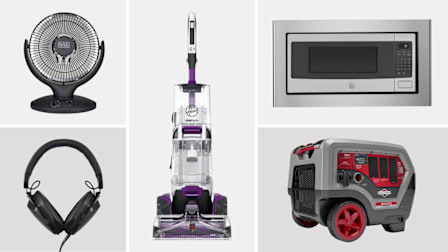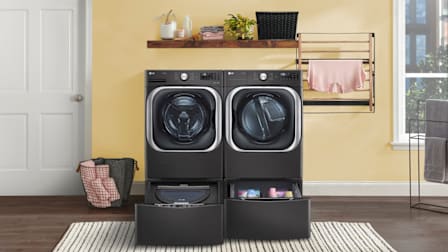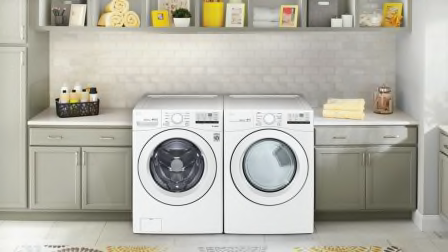8 Best Eco-Friendly Washing Machines of 2026
Our Green Choice designation will help you find a new washer that's easy on the environment
When you shop through retailer links on our site, we may earn affiliate commissions. 100% of the fees we collect are used to support our nonprofit mission. Learn more.

When you’re shopping for a new washing machine, you want one that gets your clothes clean, of course. But what if you could invest in a machine that helps keep the environment clean, too?
Consumer Reports’ Green Choice designation helps you do that by identifying the washing machines in our ratings that we’ve determined have the least environmental impact. These models, which also meet performance standards, are identified with a green leaf icon.
To earn a leaf, products must attain a Green Choice score in the top 20 percent of those evaluated. Of the approximately 120 washing machines currently in our ratings, the Green Choice designation applies to five front-loaders, four HE top-loaders, four compact models, and two top-load agitators. They include brands such as Blomberg, Electrolux, GE, LG, Samsung, and Whirlpool.
CR members can read on for ratings and reviews of some of the highest-performing Green Choice washers from our tests. For more information as you shop, see our washing machine buying guide. For a comprehensive look at all the washers we test, visit our complete washing machine ratings. And if you’re interested in pursuing a green lifestyle beyond laundry, check out CR’s Guide to Sustainable Living.
Best Eco-Friendly Front-Loaders
Five of our Green Choice washers are front-loaders, which are among the most water-efficient machines you can buy. (They use an average of 10 gallons of water per load compared with 13 gallons for high-efficiency top-loaders and 20 gallons for top-load agitators.) Here are the top three, which are also CR Recommended.
Best Eco-Friendly Compact Front-Loaders
Four compact front-loaders earn our Green Choice designation. Notably, the two top-rated models are even more budget-friendly than other compact washers in our tests.
Best Eco-Friendly HE Top-Loaders
Four high-efficiency (HE) top-load washing machines in CR’s ratings earn the Green Choice designation. Here are the top two, both of which are CR Recommended.
Best Eco-Friendly Agitator Top-Loaders
Two top-load agitators earn a Green Choice leaf in our ratings, but only one is CR Recommended, based on its Overall Score.
What Makes a Washing Machine a Green Choice?
CR’s Green Choice program evaluates a product’s environmental impact throughout its entire life cycle—from manufacture to distribution, use, and eventual disposal. Whether a washing machine gets a Green Choice leaf is determined by factors that primarily include energy and water consumption, the amount of materials used in its manufacture, and its performance in our tests. To a lesser degree, we consider specific materials that relate to durability (such as stainless steel drums), the country of origin, the gentleness of the machine on clothes, and affordability. The length of a washer’s warranty and its reliability (based on our member surveys) are also weighed. All current Green Choice washers are Energy Star certified, meaning they use 20 percent less energy and about 30 percent less water than conventional washers.
Why Choose a Green Choice Washer?
Washing machines are essential household appliances with a significant environmental footprint, so making them as efficient as possible benefits consumers. In 2024, CR supported a proposal by the Department of Energy to raise efficiency standards for various home appliances and equipment, including washing machines. Those higher standards, scheduled to go into effect in 2028, were rolled back in February 2025.
“When we increase the efficiency of the appliances we use every day, it means we’re using less energy, water, and other resources; so more money lands in consumers’ pockets, and there’s less demand on electrical grids and water systems,” Shanika Whitehurst, Consumer Reports’ associate director for product sustainability, research, and testing, said at the time. According to the DOE, the higher standards would have saved American households $2.2 billion per year on their utility bills while significantly cutting energy waste and harmful carbon pollution.
Fortunately, Whitehurst says, most modern, top-rated washing machines are already designed for efficiency. “There are washers and dryers available today that already meet the new efficiency standards,” she says. “But without new efficiency standards for all washing machines, manufacturers have little incentive to improve energy efficiency in lower-priced models. These lower up-front costs, which may seem appealing at first, may cost you more in operation later.”
































